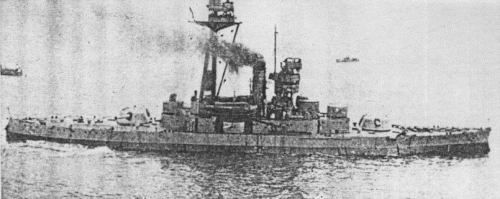
NAVYPEDIA
 Support the project with paypal
Support the project with paypal
Photo

Gorgon 1918
Ships
| Name | No | Yard No | Builder | Laid down | Launched | Comp | Fate |
|---|---|---|---|---|---|---|---|
| Glatton (ex-Bjørgvin) | N03, N50 | 861 | Armstrong, Elswick | 26.5.1913 | 8.8.1914 | 9.1918 | internal explosion 16.9.1918 |
| Gorgon (ex-Nidaros) | P59, N51 | 862 | Armstrong, Elswick | 11.6.1913 | 9.6.1914 | 6.1918 | test ship 1921, sold for BU 8.1928 |
Technical data
| Displacement normal, t | 5700 |
|---|---|
| Displacement full, t | 5746 |
| Length, m | 94.5 |
| Breadth, m | 22.4 |
| Draught, m | 5.00 deep |
| No of shafts | 2 |
| Machinery | 2 VTE, 4 boilers |
| Power, h. p. | 4000 |
| Max speed, kts | 12 |
| Fuel, t | coal 364 + oil 171 |
| Endurance, nm(kts) | 2500(10) |
| Armour, mm | belt: 178-76, bulkheads: 102 - 76, barbettes: 203 - 152, turrets: 203 (face), CT: 203, decks: 63 - 25 |
| Armament | Gorgon: 2 x 1 - 234/51 BL Mk XII, 4 x 1 - 152/49 BL Mk XVIII, 2 x 1 - 76/45 20cwt QF Mk I, 4 x 1 - 40/39 2pdr QF Mk II Glatton: 2 x 1 - 234/51 BL Mk XII, 4 x 1 - 152/49 BL Mk XVIII, 2 x 1 - 76/45 20cwt QF Mk I, 4 x 1 - 47/50 3pdr Vickers Mk I, 2 x 1 - 40/39 2pdr QF Mk II |
| Complement | 305 |
Graphics
Project history
The Norwegian Government had ordered two coast defence battleships, Nidaros and Bjorgvin, in January 1913, to be armed with 240mm and 150mm guns and capable of 15kts. The first named was launched on the Tyne in June 1914 and her sister just after the outbreak of war, and by November 1914 the Admiralty was negotiating with the Norwegians to take them over for conversion to monitors. The two-thirds of the contract price already paid was refunded and the ships were bought for a total of £370,000 each. In January 1915 the builders were given orders to begin the conversion, principally to modify the guns to take standard British shells, and to provide for additional fuel to increase endurance. In addition the boilers were converted to dual coal-oil-firing. At first the work was given top priority but in May 1915, with 10-12 months` work still to do, work was suspended to expedite Courageous and Furious. In September 1917 Armstrongs were asked to complete the ships to a revised design, with wide anti-torpedo 'bulges'. The TT were removed, elevation of the main armament increased to 40° and a heavy tripod mast was fitted. Three of the guns had been completed as 240mm and were relined to 234mm, while No 4 gun was finished to the new calibre. With 40° elevation the new gun could range to 35.5km with special 8crh shells (the 4crh shell fitted with a long ballistic cap), a range exceeded only by the 457mm in the General Wolfe and Lord Clive. The ships were also give a new high-angle armament, an the result was a pair of highly effective monitors. Speed was now down by 2kts, thanks to the 'bulges' and Gorgon and Glatton made 13kts and 12kts respectively on trials.
Protection
There were bulges intended for underwater protection. The citadel was consisted of 178-76mm belt, 102-76mm bulkheads and 63-25mm armoured deck.
Modernizations
None.
Naval service
Glatton commissioned at Newcastle on 31 August 1918 and arrived at Dover 11 September. A week later, while she was lying in Dover harbour, her midships 152mm magazine exploded and she caught fire. Attempts to scuttle her were impossible because the flames had taken hold, and Admiral Keyes ordered the destroyer Cossack to torpedo her. The first failed to detonate but the second blew a large hole in her starboard side. Two more 533mm torpedoes from the Myngs were needed before she heeled over and sank (over half her crew were killed or injured). Although the Board of Enquiry reported in April 1919 that cork insulation might have been ignited by red-hot clinker and ash piled against the magazine bulkhead (the stokers being unaware that a magazine was on the other side) the Engineer-in-Chief and the DNC recorded their disagreement. Only when the Gorgon`s insulation was being stripped out did it become obvious that in some places the granulated cork had never been put in. Instead there were newspapers - far more likely to char and burst into flame than cork. Although the verdict of the enquiry was never formally reversed it seems clear that this was the cause of the magazine fire and explosion in Glatton. The wreck was raised May 1925-March 1926 and BU in situ. Gorgon was sent to Portsmouth in November 1918 to await decision about her disposal; took part in trials to determine the cause of Glatton`s loss and her resale to Norway was discussed. She arrived to Devonport in April 1919 as temporary tender to Vivid, and paid off in August. Sale to Argentina, Peru and Rumania was discussed in 1920 (Rumania offered c£60,000 for Gorgon and £140,000 for six 'M' class destroyers). Disarmed 1921 for use in further trials; towed back to Portsmouth in June 1922 and used as target for bombs and shells.
Many thanks to Wolfgang Stöhr for additional information on this page.
 HOME
HOME FIGHTING SHIPS OF THE WORLD
FIGHTING SHIPS OF THE WORLD UNITED KINGDOM
UNITED KINGDOM GORGON monitors (2, 1918)
GORGON monitors (2, 1918)
